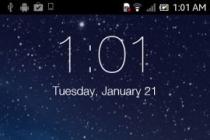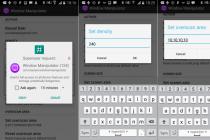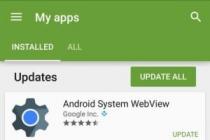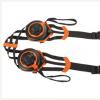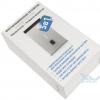This year, Nokia introduced a new line of smartphones using the Android platform, albeit in a radically redesigned form. We tested the largest representative of this new cohort - Nokia XL.
Characteristics:
Communication: GSM/EDGE/UMTS (DualSIM)
Screen: IPS, 5 inches, 800 x 480
OS: Nokia X 1.0 (based on Android 4.1.2)
Processor: Qualcomm Snapdragon S4 (MSM8225), Adreno 203
RAM: 768 MB
User Memory: 4 GB, microSD expansion slot
Connectors: microUSB, audio output 3.5 mm
Wireless modules: Bluetooth 3.0, Wi-Fi
Camera: front - 2 MP, main - 5 MP
Dimensions: 141.4x77.7x10.9 mm
Weight: 190 g.
Battery: 2000 mAh
Extras: GPS, FM radio
Price: 1999 UAH
Despite the fact that the Nokia X series stands apart from other devices from the company, in terms of design it still uses the same combination of bright colors and classic shapes. As a result, the model is outwardly easy to confuse with more expensive Lumia smartphones. Well, the hero of our review is only good.


The manufacturer, apparently, did not set a goal to make Nokia XL thin or light. If we are to make a 5-inch smartphone, then there is no point in trifles. Calling the device thin by modern standards will not work, and its weight exceeds even some 6-inch devices.
On the other hand, how could it be otherwise, because you are buying a thing with the abbreviation XL in the title. Nevertheless, the device looks and feels solid and well-assembled in the hands.
Despite the large diagonal, the screen resolution is not very high - 800 x 480 pixels. In general, the picture is bright and contrasting, the viewing angles will not disappoint either, but there is moderate pixelation here. But the low screen resolution has a positive effect on the autonomy of the gadget.


Special thanks to the manufacturer for supporting two SIM-cards. In Nokia smartphones, this is perceived as a pleasant innovation, while in the CIS countries the function is incredibly popular.
Both cards are connected at the same time. But when one of them receives a call, the second remains without communication until the conversation is over. Without support for 3G technology UMTS is also not done.
The Nokia XL uses a Qualcomm Snapdragon S4 (MSM8225) dual-core processor and 768MB of RAM. In AnTuTu Benchmark, the device scored about 8000 points, which is not very much, but typical for a state employee. The interface seems to be well optimized, so there are no slowdowns in everyday tasks. But counting on dynamic 3D games, of course, is not worth it.



The operating system uses a modified version of Android 4.1.2, which the manufacturer calls Nokia X Platform. Interface changes compared to stock Android are so significant that, indeed, there is a feeling that we are facing a completely different platform.


Literally everything has been redesigned, from the icon design to the menu organization scheme itself. There are certain similarities with Windows Phone - the same "tiles" on the main screen. Obviously, the company is trying to make it easy for a user who has tried Nokia X to switch to, for example, Lumia.


But the main advantage of the platform, perhaps, is that it is compatible with Android applications. True, not without reservations. So, the device does not have the usual Google services, like the Play Market. Therefore, applications are suggested to be installed from the Nokia store or other alternative “markets”.
It may be difficult for the user to find a specific game or a familiar mailing program for this smartphone. By the way, if you are looking for such software or service, we can recommend the Prosto.email solution (prostoemail.ru), which works directly in the browser. This is a popular mailing system, highly effective and, importantly, quite affordable. In general, unlike specialized software, the user will have all the basic software for Nokia XL. Of the preinstalled Nokia services, I would especially like to mention the Here navigation, which also works offline.
The resolution of the built-in camera is only 5 megapixels. However, to say that she is here for show would be unfair. Apparently, the camera copes with its task as well as possible, given the hardware used.
In general, making a good shot during daylight hours and in good weather is not a problem at all. For shooting at dusk and indoors, you can use the built-in flash, which, by the way, is not in the younger model - Nokia X.
The large dimensions of the body made it possible to install a fairly capacious 2000 mAh battery in Nokia XL. In combination with a low-resolution display and an economical processor, it provides good autonomy. In our case, this is about two days of active work.

Summary
Nokia XL is a relatively inexpensive smartphone with a nice design, dual SIM support and pre-installed Nokia services. First of all, it can be recommended to fans of the brand. For example, those who used to use ordinary push-button telephones, but are now “ripe” for something more functional. Nevertheless, there are many alternatives on Android, which sometimes offer more powerful hardware and familiar Google services for the same price - the same Play Market. True, Nokia XL is clearly more interesting in appearance - inexpensive Android smartphones rarely boast a striking design. The choice is yours.
The company believed that Nokia smartphones with Android OS would not allow them to stand out from other manufacturers. As an alternative, the well-known Windows Phone platform was chosen. And although it has gained enough popularity recently, Android smartphones from other companies are sold much more often. Android smartphones are becoming more functional every year, while their price is decreasing. Given this, Nokia decided to create their own version of Android. The developers were faced with the task, on the one hand, to create a smartphone that will run Android applications, on the other hand, it was important that the device was not called an Android smartphone and there was no mention of Google. The operating system has changed beyond recognition. The company has put a lot of effort into making it look different from regular Android. The interface of the new operating system is a combination of elements from the operating systems Windows Phone, Android and Asha. The home screen is very similar to the screen from the Windows Phone OS.
The first smartphone based on the new operating system, Nokia XL, was presented by the company on February 24, 2014 at the Mobile Congress in Barcelona. The positioning of Nokia's new smartphone is very simple - "bright smartphone for Android applications." The main audience of this device is young people who feel the need for a smartphone, but do not want to spend a lot of money on it. Also, enthusiasts and software developers, those who like to explore everything new, may be interested in the smartphone. Today we will take a closer look at the novelty and try to identify all the pros and cons of the smartphone.
Contents of delivery
The Nokia XL smartphone comes in a compact cardboard box, which is already familiar to other Nokia products. In the kit, in addition to the smartphone itself, you will find:
— Charger AC-20
— Battery Nokia BN 02 2000 mAh
- Nokia Stereo Headset WH-108
- Quick Guide
The equipment is rather poor, but it is due, first of all, to the low price of the smartphone.
Design
Nokia has always tried to be different in terms of design. The company's engineers often experimented with the appearance of their smartphones, but one of the most successful, according to users, was the design of Nokia Lumia. In Nokia XL, as well as in the Asha line, they tried to create a cheaper version of the case, similar in appearance to the Lumia line. However, the Nokia XL smartphone uses inexpensive plastic, and the case is disassembled.
Another feature that is typical only for Nokia smartphones is a wide variety of color solutions. If most companies try not to present many different body colors, Nokia, on the contrary, considers this a plus. Thanks to this, the user always has the opportunity to choose exactly the color that he likes.
Smartphone Nokia XL can not be called compact. It measures 77.72mm x 141.35mm x 10.87mm and weighs 190g. The smartphone feels quite wide, and the sharp corners make it a little uncomfortable in the hand. If you convey the feeling in words, the device can be described as a "heavy brick". However, Nokia XL was created just for lovers of large smartphones, so the buyer will probably be ready for such dimensions of the device.
As for ergonomics, everything is familiar here. On the right side of the smartphone is a paired volume rocker, just below the on/off button.

At the top end there is a 3.5 mm jack.

The microUSB connector is located on the bottom. The left side of the smartphone is completely empty. It doesn't have any buttons.

The back surface of the smartphone is quite simple. It has a speaker hole, a 5-megapixel camera lens and a flash, as well as the Nokia logo. On the front panel there is a front camera for video calls and a single button under the screen, which plays a dual role: a short press - a step back, a long press - return to the home screen. The solution is ambiguous. Some will like it, some won't. Matter of habit.

The build quality of the smartphone does not cause any complaints. A matte case is used, when pressed, it does not play and does not hold together. For a budget device, the quality of the materials from which the case is made is excellent.
Under the back cover is the battery, as well as two slots for microSIM cards and a slot for a microSD memory card.

Display
The smartphone uses a 5-inch screen. An IPS-matrix with a resolution of 800x480 pixels and a color depth of 24 bits is installed. In most situations, the picture looks good. However, considering the screen size, the resolution is not enough. Nevertheless, if you do not require something special from the device, the majority of users should like the screen. The brightness of the display is quite high, there is an automatic adjustment. In bright light, the image dims, but remains readable.


The display of the Nokia XL smartphone has good viewing angles, the image is not distorted when tilted.

I did not like the fact that the fonts do not have anti-aliasing, in most situations they do not look very good. In any Android smartphone from any other manufacturer, there is no such problem with fonts as on Nokia XL. The same situation is with the menu icons. They are not very well adapted to the screen resolution and to the operating system. I hope the company will fix this shortcoming in the next updates of the operating system. In the screen settings, you can specify the display of the clock in standby mode. This feature has been used in Nokia phones and smartphones for a long time and will be very useful if the user does not wear a watch. The Nokia XL smartphone also has a proximity sensor, during a call the screen is locked.
Technical features
The Nokia XL smartphone is built on a Qualcomm chipset and is referred to on the Nokia website as the Snapdragon S4 Play MSM8225. This is already a rather outdated type of chipset. Even the not new Nokia Lumia 520 uses the MSM8227 chipset, which is somewhat more productive. Nokia XL dual-core processor clocked at 1 GHz. The device uses the Adreno 203 graphics coprocessor, its performance is also quite low. Among the "budget" devices Nokia XL is not the most productive solution. The reason is the use of inexpensive components from Qualcomm, which are inferior to analogues from other manufacturers. However, if you do not intend to run resource-intensive 3D games and heavy applications on Nokia XL, the performance of the device will be enough for you.
Nokia XL has 4 GB of internal memory, as well as 768 MB of RAM. Unfortunately, all devices built on the platform from Qualcomm are more demanding on RAM than their counterparts on MediaTek. After downloading, about 326 MB of RAM is free. Android's memory management is good enough that apps get the right amount of memory and use as much memory as possible.
For data storage, 1.29 GB is allocated in the phone's memory, 1.17 GB is shown as a memory card, plus the user can install their own memory card up to 32 GB. The main disadvantage of the nokia XL operating system is that all applications are installed in the phone's memory, that is, the user is limited to exactly 1.29 GB in size and this cannot be avoided. Installing applications on a memory card is not yet supported. Perhaps this will be fixed in the next versions of the operating system.
In all other respects, the Nokia XL is a typical Android smartphone. There is the ability to transfer files via Bluetooth, there is Wi-Fi, there is a USB Mass Storage mode when connected to a PC.
The Nokia XL smartphone supports two SIM cards, but there is only one radio module in the device, so only one SIM card can be active at a time. This is a cheaper version of the implementation of the presence of two SIM-cards, which is currently the most common on the market and in devices of this price segment. The smartphone supports WCDMA networks: 900 MHz, 2100 MHz and GSM networks: 850 MHz, 900 MHz, 1800 MHz, 1900 MHz. In the settings, you can choose one card for SMS/MMS/calls, or specify them as standalone, that is, they work independently. The list of calls indicates which card you called from.
Interface
The Nokia XL interface is a collection of elements from the Windows Phone, Android and Asha operating systems. The smartphone is awakened using the side key or by tapping on the end. We see the lock screen, which can display the latest events - mail, SMS, calls, programs, and so on. You can slide your finger in one direction or another to get into the selected program or remove this reminder.


Unlike regular Android OS, there are only two options for locking the device - PIN code or password. The interface in Nokia XL has been redesigned so much that it's hard to recognize ordinary Android. The whole ideology of Android was forgotten, and instead Nokia came up with the concept of Fastlane.
If you move the home screen to the side, a menu will open, which is called Fastlane. The menu is copied from Nokia Asha budget phones. Fastlane is a hybrid of a news feed, a notification bar, and a list of recently launched programs. By clicking on an entry in Fastlane, the user enters the program that sent this entry. Unfortunately, by default, there is no task manager in the phone, however, as well as multitasking. You can switch between applications through Fastlane, but whether they were unloaded from memory or not is impossible to know.


The main menu is tiles like those used in the Windows Phone OS: Phone, Contacts, SMS, Internet, Store, Email, and so on. All installed programs are displayed on one screen. It is possible to create folders and save icons inside folders.



Icons can be swapped, the necessary ones can be brought up, while you can change the color of the tiles for the icons. You can use search to find an app. To do this, drag the entire page down, then a search will appear in which you can type the name of the program.
As in regular versions of Android, the Nokia XL operating system has a drop-down curtain that has 4 quick shortcuts, the ability to switch between SIM cards, and a quick exit to settings.

The settings menu looks like a normal Android.


All modern Android smartphones have such a feature as voice typing. In Nokia XL, the Pico TTS engine is responsible for speech synthesis, which is familiar from many models from different manufacturers, it is quite primitive and does not have the Russian language. Therefore, in terms of voice dialing, Nokia needs to refine its new smartphones.
With the keyboard, things are much better. It's called the Nokia Keyboard. You can, without lifting your finger, enter words, and they are foreseen.

In the ad, Nokia says it's a smartphone for Android apps, without specifying if all of them will be supported. Nokia's branded store has a small number of programs, it can never come close to the branded Play Store. Applications are still few. For example, Whatsapp is missing, as is Google's Chrome browser. When you search for an app in the store and don't find it, there are five more app stores to choose from, including the Yandex Store.
However, many Nokia XL users have already found an easy way to install applications. They take a regular Android smartphone, find and download the app's APK file, then transfer it via Bluetooth and install it on the Nokia XL. Not the easiest, but really working option.
Nokia does not guarantee the operation of all Android applications on its device. Many applications require registration in the Play Store, which is not and will not be here, as well as there is no support for Google services. There is support only for Yandex services.

When buying an Android smartphone, usually a user can easily sync their contacts with a Google account and transfer them to a new device in a matter of seconds. This is standard functionality for Android and for any smartphone. However, Nokia XL does not allow you to get contacts from the cloud. There are only two ways to transfer contacts. One is to use the Yandex service, the second way is to save all contacts to a microSD card, then insert it into Nokia X and try to read it. Why Nokia refused to synchronize contacts with the cloud in its new smartphone is not clear.

Built-in applications in general do not cause any complaints. Calculator, alarm clock, browser - everything works.



Liked the navigation. Here Maps allows you to download files for countries and regions to your memory card, which is great. The main memory will be free, but how many maps of different countries and cities you load onto a memory card will depend only on its volume. The usual and familiar navigation interface is used, including for offline navigation.

The music player is normal, FM radio works only with a headset.


Camera
The Nokia XL smartphone has a 5-megapixel main camera and a 2-megapixel front camera. Main camera resolution: 2592 x 1944 pixels. There is an LED flash and auto focus. Camera features: auto and manual white balance, active toolbar, photo editor, face detection, auto exposure, center-weighted auto exposure. The camera has a "panoramic shooting" function. Available color modes: sepia, solarized, normal, negative. White balance modes: cloudy, incandescent, fluorescent, daylight, auto. The camera can shoot video in FWVGA (864 x 480) format at 30 fps.
Secondary camera resolution: 1600 x 1200 pix. A wide-angle lens is being used.
In the daytime, with good lighting, the photos are quite good. With artificial lighting, things are a little worse. Examples of photos taken with the Nokia XL camera:


Battery
The smartphone uses a removable lithium-ion battery with a capacity of 2000 mAh. According to the manufacturer, the maximum talk time in 2G networks is 16 hours, the waiting time in 2G networks is 720 hours. The maximum talk time in 3G networks is 13 hours, the standby time in 3G networks is 720 hours. With frequent use, the smartphone, of course, like other Android devices, will live daylight hours, but in general, the battery life of the smartphone is very good.
Conclusion
Nokia XL has a lot of pros and cons. The smartphone has a good ringtone volume, a high-quality case with bright colors, and a nice-looking screen. I did not like the stripped-down Android with an unusual interface, but perhaps this is a matter of habit. Iron is weak. The smartphone does not support resource-intensive applications and HD-video. The camera is average, but in good lighting, the photos are not bad. The main buyers of the novelty will be young people who want to get a bright, stylish smartphone with support for Android applications for little money. Nokia has made a new, unique product. If the company manages to keep a nice price, the smartphone should become popular.
This smartphone is Nokia's answer to the "requests" and "wishes" of the market to see a handset running from the former leader of the mobile industry. A controversial decision in many respects, including alterations in the axis itself and the final price tag for the user. But let's talk about everything in order.
Contents of delivery
If you're already tired of the blue packaging for Nokia devices, you'll be in for a little surprise with the XL - no blue, except for a small insert. Yes, the form factor has not been changed, but the appearance in a certain sense of the word has been “refreshed”, which is not bad.

Opening it, the user will find, of course, the smartphone itself, as well as a charger, warranty documentation and user manual, plus a wired headset with an answer button. But for some reason there is no micro-cable in the box, and this is despite the fact that such an accessory is provided for even more affordable solutions from competitors.

Design and build quality
If you expected that the appearance of the novelty will cause you, as they say, a wow effect, I hasten to reassure you - there is no sensation. The design of the XL dual-SIM is a cross between the Asha and Lumia lines. However, let's be fair, the model is in a relatively affordable price division, and besides, on a different platform. Thus, if only because of this, it is not obliged to have a radically changed appearance. Here the manufacturer has chosen the right path.

The dominant material of the case is polycarbonate, from which the back panel is made, as well as the "sides". The material is strong! For the sake of sporting interest, I tried to leave at least a slight mark on the surface. But, alas, even intense friction with the edge of the coin was not enough to achieve this goal.

At first glance, it seems that the case is non-separable and the user does not have access to the battery. Nevertheless, it is enough to examine the ends once already to ask yourself: “Where are the slots for SIM cards”!? The answer will be obvious.
You will have to get used to how the battery pack cover is removed, although not for long. It is best to perform this procedure by prying it on the left side edge. It's a little uncomfortable at first, but you get used to it over time. But thanks to this arrangement, it does not play against the body, which is also a plus!

However, the fitting of other elements to each other turned out to be good - no creaking, backlash or tangible gaps.

The handset sits well in the hand, thanks to the matte polycarbonate and, in my opinion, a noticeable weight - 190 grams. The device seems protected, does not burden the palm, and long-term use is quite comfortable. By the way, despite the presence of a 5-inch display "on board", the user can reach any hardware button and almost any touch.
Functional elements
The front panel of the smartphone is divided between a large display, earpiece slot, front 2 megapixel camera eye, light/proximity sensors, one touch button slightly below the display, and a built-in microphone slot. As for the mentioned key, it is responsible for the transition to the previous menu sub-item.

On the back side, which, as we remember, is completely covered by the battery pack cover, there is a peephole for the main camera and a flash, plus a speakerphone output. Here, with the help of special paint, the logo of the manufacturer is applied.

Inspecting the right side face, the user will "find" the volume rocker, as well as the power on / off button of the device.

No functional elements are provided on the opposite edge.

The top end is notable for the classic audio jack, and the bottom micro-USB port.


Brief technical specifications
| Cellular network standard | 850/900/1800/1900 MHz; 900/2100 MHz |
|
Dimensions | 141.4x77.7x10.9 mm |
|
Weight | 190 g |
|
Guarantee
| 12 months |
Display
Nokia XL has a 5-inch matrix-based display. Resolution, in my opinion, is very modest - 480x800 pixels. Pixelation is visible, as they say, "to the naked eye."
Viewing angles are average both vertically and horizontally.

When working with the handset in bright sunlight on the panel, the displayed information “blinds”, although you can read the data.
Backlight adjustment is carried out both manually and automatically.
In addition, in the corresponding settings submenu, the user can activate or disable auto-rotate the screen, set up sleep mode, and also activate the “Double tap” function. The latter "brings" the smartphone out of sleep mode by double tapping on the panel with your finger.






There are no problems with sensitivity - touch control is supported using five fingers at the same time.

The display is covered with tempered glass. I will say without prerequisites, the classic test, friction on the panel with the edge of a coin, was not enough for the appearance of marks.
Memory
With 4 GB of officially declared internal memory, a little more than 2 GB is available to the user: 1.12 GB is an internal USB drive, and another 1.19 GB is for installing applications.



The expansion is provided by memory cards up to 32 GB inclusive. "Hot" replacement of drives is not supported, as, by the way, and USB OTG.

Speakers
Nokia XL dual-SIM has two separate speakers - internal or communication, as well as speakerphone.

The capabilities of both are at a fairly good level. They probably won’t be able to stand out with something particularly interesting here, however, this opportunity is not determined by the price, but talking while on the street or a loud avenue, hearing a call while going down the subway, or listening to MP3 in a room - all this Maybe.

The settings in the corresponding submenu are classic.


Battery and autonomy
Removable battery capacity 2000 mAh.
It is officially stated that on a single charge, the smartphone is able to work in talk mode for 16 hours.

In practice, one charge is enough for 2 days of work with a total load of at least 1.5 hours of calls, about 3 hours of WEB surfing and e-mail, up to 40 minutes of camera and video, the same amount of games. In my opinion, this is quite a good indicator.
There are no proprietary power-saving add-ons provided.
Equipment and performance
Nokia XL dual SIM runs a customized Android 4.1, which is called Nokia X software platform 1.1 here.

The user will not see any “binding” to Goolge services here. There is also no access to the Play store! Instead, the Nokia store is offered.
The "heart" of the system is a 2-core Qualcomm Snapdragon S4, clocked at 1 GHz. In addition, 768 MB of RAM and Adreno 203 graphics are on board.



As for the wireless modules and interfaces available in Nokia XL dual SIM, it is worth noting the presence of: 802.11 b/g/n; in the third edition, as well as the already mentioned support for dual-SIM mode, however, only in standby mode. In the settings sub-item of the same name, the user can set one of the "SIMs" as a priority, set the ability to select a card immediately before making a call, etc.





Performance testing was done with several popular utilities. Below are the results.






Shell
The skin in the Nokia XL dual SIM is a bizarre mixture of live icons from Windows Phone, as well as a notification bar plus a settings submenu from Android.
In fact, to be extremely precise, the icons in XL are more static than "live" - if you do not influence them in any way, then you will not be able to see the movement in response.


All these windows can be edited by the user. "Changes" of the main ones are reduced only to manipulations with their sizes. But not the main ones can be resized, “painted” in different colors, and if not needed, deleted. In addition, it is possible to create folders on the main page and save several application icons of the same style in them. Widgets can be placed on the main screen.





On the notification panel, you can select a priority SIM card, as well as quick access to shortcuts for wireless interfaces, etc.


Camera
Main 5 megapixel camera with flash and autofocus for taking photos.
In addition, the user has the ability to adjust , saturation, activate the face detection item and much more.
- test photo



- test video
Impression
With a price tag of more than two thousand hryvnia and such a potential, Nokia XL dual-SIM will be of interest only to fans of the brand. It's no secret that today with the same "iron under the hood" competitors can offer smartphones for 2-3, or even all 4 hundred hryvnia cheaper. However, it is likely that after the so-called "first wave" on the market, we should expect a certain decrease in the cost. The red price of the novelty, in my opinion, is 1600-1800 hryvnia.

pros
High-quality body materials and excellent assembly;
Tempered glass/double tap features;
Good autonomy
Minuses
Lack of a micro-USB cable in the package; Display resolution;
It is not possible to connect external drives;
Overpriced
Estimated price: 2140 hryvnia
The product is provided by the press service of Nokia in Ukraine
Sergei Reshodko
The company believed that Nokia smartphones with Android OS would not allow them to stand out from other manufacturers. As an alternative, the well-known Windows Phone platform was chosen. And although it has gained enough popularity recently, Android smartphones from other companies are sold much more often. Android smartphones are becoming more functional every year, while their price is decreasing. Given this, Nokia decided to create their own version of Android. The developers were faced with the task, on the one hand, to create a smartphone that will run Android applications, on the other hand, it was important that the device was not called an Android smartphone and there was no mention of Google. The operating system has changed beyond recognition. The company has put a lot of effort into making it look different from regular Android. The interface of the new operating system is a combination of elements from the operating systems Windows Phone, Android and Asha. The home screen is very similar to the screen from the Windows Phone OS.
The first smartphone based on the new operating system, Nokia XL, was presented by the company on February 24, 2014 at the Mobile Congress in Barcelona. The positioning of Nokia's new smartphone is very simple - "bright smartphone for Android applications." The main audience of this device is young people who feel the need for a smartphone, but do not want to spend a lot of money on it. Also, enthusiasts and software developers, those who like to explore everything new, may be interested in the smartphone. Today we will take a closer look at the novelty and try to identify all the pros and cons of the smartphone.
Contents of delivery
The Nokia XL smartphone comes in a compact cardboard box, which is already familiar to other Nokia products. In the kit, in addition to the smartphone itself, you will find:
— Charger AC-20
— Battery Nokia BN 02 2000 mAh
- Nokia Stereo Headset WH-108
- Quick Guide
The equipment is rather poor, but it is due, first of all, to the low price of the smartphone.
Design
Nokia has always tried to be different in terms of design. The company's engineers often experimented with the appearance of their smartphones, but one of the most successful, according to users, was the design of Nokia Lumia. In Nokia XL, as well as in the Asha line, they tried to create a cheaper version of the case, similar in appearance to the Lumia line. However, the Nokia XL smartphone uses inexpensive plastic, and the case is disassembled.
Another feature that is typical only for Nokia smartphones is a wide variety of color solutions. If most companies try not to present many different body colors, Nokia, on the contrary, considers this a plus. Thanks to this, the user always has the opportunity to choose exactly the color that he likes.
Smartphone Nokia XL can not be called compact. It measures 77.72mm x 141.35mm x 10.87mm and weighs 190g. The smartphone feels quite wide, and the sharp corners make it a little uncomfortable in the hand. If you convey the feeling in words, the device can be described as a "heavy brick". However, Nokia XL was created just for lovers of large smartphones, so the buyer will probably be ready for such dimensions of the device.
As for ergonomics, everything is familiar here. On the right side of the smartphone is a paired volume rocker, just below the on/off button.

At the top end there is a 3.5 mm jack.

The microUSB connector is located on the bottom. The left side of the smartphone is completely empty. It doesn't have any buttons.

The back surface of the smartphone is quite simple. It has a speaker hole, a 5-megapixel camera lens and a flash, as well as the Nokia logo. On the front panel there is a front camera for video calls and a single button under the screen, which plays a dual role: a short press - a step back, a long press - return to the home screen. The solution is ambiguous. Some will like it, some won't. Matter of habit.

The build quality of the smartphone does not cause any complaints. A matte case is used, when pressed, it does not play and does not hold together. For a budget device, the quality of the materials from which the case is made is excellent.
Under the back cover is the battery, as well as two slots for microSIM cards and a slot for a microSD memory card.

Display
The smartphone uses a 5-inch screen. An IPS-matrix with a resolution of 800x480 pixels and a color depth of 24 bits is installed. In most situations, the picture looks good. However, considering the screen size, the resolution is not enough. Nevertheless, if you do not require something special from the device, the majority of users should like the screen. The brightness of the display is quite high, there is an automatic adjustment. In bright light, the image dims, but remains readable.


The display of the Nokia XL smartphone has good viewing angles, the image is not distorted when tilted.

I did not like the fact that the fonts do not have anti-aliasing, in most situations they do not look very good. In any Android smartphone from any other manufacturer, there is no such problem with fonts as on Nokia XL. The same situation is with the menu icons. They are not very well adapted to the screen resolution and to the operating system. I hope the company will fix this shortcoming in the next updates of the operating system. In the screen settings, you can specify the display of the clock in standby mode. This feature has been used in Nokia phones and smartphones for a long time and will be very useful if the user does not wear a watch. The Nokia XL smartphone also has a proximity sensor, during a call the screen is locked.
Technical features
The Nokia XL smartphone is built on a Qualcomm chipset and is referred to on the Nokia website as the Snapdragon S4 Play MSM8225. This is already a rather outdated type of chipset. Even the not new Nokia Lumia 520 uses the MSM8227 chipset, which is somewhat more productive. Nokia XL dual-core processor clocked at 1 GHz. The device uses the Adreno 203 graphics coprocessor, its performance is also quite low. Among the "budget" devices Nokia XL is not the most productive solution. The reason is the use of inexpensive components from Qualcomm, which are inferior to analogues from other manufacturers. However, if you do not intend to run resource-intensive 3D games and heavy applications on Nokia XL, the performance of the device will be enough for you.
Nokia XL has 4 GB of internal memory, as well as 768 MB of RAM. Unfortunately, all devices built on the platform from Qualcomm are more demanding on RAM than their counterparts on MediaTek. After downloading, about 326 MB of RAM is free. Android's memory management is good enough that apps get the right amount of memory and use as much memory as possible.
For data storage, 1.29 GB is allocated in the phone's memory, 1.17 GB is shown as a memory card, plus the user can install their own memory card up to 32 GB. The main disadvantage of the nokia XL operating system is that all applications are installed in the phone's memory, that is, the user is limited to exactly 1.29 GB in size and this cannot be avoided. Installing applications on a memory card is not yet supported. Perhaps this will be fixed in the next versions of the operating system.
In all other respects, the Nokia XL is a typical Android smartphone. There is the ability to transfer files via Bluetooth, there is Wi-Fi, there is a USB Mass Storage mode when connected to a PC.
The Nokia XL smartphone supports two SIM cards, but there is only one radio module in the device, so only one SIM card can be active at a time. This is a cheaper version of the implementation of the presence of two SIM-cards, which is currently the most common on the market and in devices of this price segment. The smartphone supports WCDMA networks: 900 MHz, 2100 MHz and GSM networks: 850 MHz, 900 MHz, 1800 MHz, 1900 MHz. In the settings, you can choose one card for SMS/MMS/calls, or specify them as standalone, that is, they work independently. The list of calls indicates which card you called from.
Interface
The Nokia XL interface is a collection of elements from the Windows Phone, Android and Asha operating systems. The smartphone is awakened using the side key or by tapping on the end. We see the lock screen, which can display the latest events - mail, SMS, calls, programs, and so on. You can slide your finger in one direction or another to get into the selected program or remove this reminder.


Unlike regular Android OS, there are only two options for locking the device - PIN code or password. The interface in Nokia XL has been redesigned so much that it's hard to recognize ordinary Android. The whole ideology of Android was forgotten, and instead Nokia came up with the concept of Fastlane.
If you move the home screen to the side, a menu will open, which is called Fastlane. The menu is copied from Nokia Asha budget phones. Fastlane is a hybrid of a news feed, a notification bar, and a list of recently launched programs. By clicking on an entry in Fastlane, the user enters the program that sent this entry. Unfortunately, by default, there is no task manager in the phone, however, as well as multitasking. You can switch between applications through Fastlane, but whether they were unloaded from memory or not is impossible to know.


The main menu is tiles like those used in the Windows Phone OS: Phone, Contacts, SMS, Internet, Store, Email, and so on. All installed programs are displayed on one screen. It is possible to create folders and save icons inside folders.



Icons can be swapped, the necessary ones can be brought up, while you can change the color of the tiles for the icons. You can use search to find an app. To do this, drag the entire page down, then a search will appear in which you can type the name of the program.
As in regular versions of Android, the Nokia XL operating system has a drop-down curtain that has 4 quick shortcuts, the ability to switch between SIM cards, and a quick exit to settings.

The settings menu looks like a normal Android.


All modern Android smartphones have such a feature as voice typing. In Nokia XL, the Pico TTS engine is responsible for speech synthesis, which is familiar from many models from different manufacturers, it is quite primitive and does not have the Russian language. Therefore, in terms of voice dialing, Nokia needs to refine its new smartphones.
With the keyboard, things are much better. It's called the Nokia Keyboard. You can, without lifting your finger, enter words, and they are foreseen.

In the ad, Nokia says it's a smartphone for Android apps, without specifying if all of them will be supported. Nokia's branded store has a small number of programs, it can never come close to the branded Play Store. Applications are still few. For example, Whatsapp is missing, as is Google's Chrome browser. When you search for an app in the store and don't find it, there are five more app stores to choose from, including the Yandex Store.
However, many Nokia XL users have already found an easy way to install applications. They take a regular Android smartphone, find and download the app's APK file, then transfer it via Bluetooth and install it on the Nokia XL. Not the easiest, but really working option.
Nokia does not guarantee the operation of all Android applications on its device. Many applications require registration in the Play Store, which is not and will not be here, as well as there is no support for Google services. There is support only for Yandex services.

When buying an Android smartphone, usually a user can easily sync their contacts with a Google account and transfer them to a new device in a matter of seconds. This is standard functionality for Android and for any smartphone. However, Nokia XL does not allow you to get contacts from the cloud. There are only two ways to transfer contacts. One is to use the Yandex service, the second way is to save all contacts to a microSD card, then insert it into Nokia X and try to read it. Why Nokia refused to synchronize contacts with the cloud in its new smartphone is not clear.

Built-in applications in general do not cause any complaints. Calculator, alarm clock, browser - everything works.



Liked the navigation. Here Maps allows you to download files for countries and regions to your memory card, which is great. The main memory will be free, but how many maps of different countries and cities you load onto a memory card will depend only on its volume. The usual and familiar navigation interface is used, including for offline navigation.

The music player is normal, FM radio works only with a headset.


Camera
The Nokia XL smartphone has a 5-megapixel main camera and a 2-megapixel front camera. Main camera resolution: 2592 x 1944 pixels. There is an LED flash and auto focus. Camera features: auto and manual white balance, active toolbar, photo editor, face detection, auto exposure, center-weighted auto exposure. The camera has a "panoramic shooting" function. Available color modes: sepia, solarized, normal, negative. White balance modes: cloudy, incandescent, fluorescent, daylight, auto. The camera can shoot video in FWVGA (864 x 480) format at 30 fps.
Secondary camera resolution: 1600 x 1200 pix. A wide-angle lens is being used.
In the daytime, with good lighting, the photos are quite good. With artificial lighting, things are a little worse. Examples of photos taken with the Nokia XL camera:


Battery
The smartphone uses a removable lithium-ion battery with a capacity of 2000 mAh. According to the manufacturer, the maximum talk time in 2G networks is 16 hours, the waiting time in 2G networks is 720 hours. The maximum talk time in 3G networks is 13 hours, the standby time in 3G networks is 720 hours. With frequent use, the smartphone, of course, like other Android devices, will live daylight hours, but in general, the battery life of the smartphone is very good.
Conclusion
Nokia XL has a lot of pros and cons. The smartphone has a good ringtone volume, a high-quality case with bright colors, and a nice-looking screen. I did not like the stripped-down Android with an unusual interface, but perhaps this is a matter of habit. Iron is weak. The smartphone does not support resource-intensive applications and HD-video. The camera is average, but in good lighting, the photos are not bad. The main buyers of the novelty will be young people who want to get a bright, stylish smartphone with support for Android applications for little money. Nokia has made a new, unique product. If the company manages to keep a nice price, the smartphone should become popular.
Nokia XL Dual SIM is a development of Nokia's line of budget mobile phones, the older brother of Nokia X, with a diagonal of 5 inches. The manufacturer added about one and a half thousand to the price and rolled out a device with a “stretched” diagonal, while leaving the same low resolution. At the same time, the dimensions of the device have increased significantly - the smartphone is uncomfortable in one hand. Unusual interface and redesigned Android - it's not so scary. However, the absence of the Play Market, in our opinion, is a serious minus. Although, it seems that consumers have even learned to live and cope with installing applications not only through the Play Market.
The processor of the beginning of 2012 is not the most recent solution, and the increase in RAM from 512 to 768 MB looks, in our opinion, simply not serious. But now the smartphone has a front camera, and the main camera has been slightly improved in terms of characteristics - its resolution is 5 MP. The manufacturer also slightly tightened the battery life - a larger case made it possible to place a more capacious battery. However, its results are still significantly below the average for smartphones in general. Among the pluses, one can only note the support for two SIM-cards, the assembly of the case and a large number of colors for it. We do not recommend a smartphone for purchase, despite the low price. In our opinion, Nokia has done a little work on the bugs and for a small surcharge pulled up the characteristics of the device to the level of inexpensive Chinese smartphones.
Dimensions and weight - 3.8
The 5-inch Nokia XL Dual SIM smartphone is thick, wide, and in its width it rather corresponds to smartphones with a 5.2-5.5-inch diagonal. The thickness of the case reaches 10.9 mm. The device is heavy, its weight is 189 grams, it is only a little short of catching up with such heavyweights as Philips W6610 or Asus Fonepad 6.
The appearance reminded us of a flattened brick, it is inconvenient to hold and control it with one hand. The case is collapsible, the battery is removed. The smartphone is made of polycarbonate, the build quality is good for a cheap model, all parts fit snugly, nothing creaks under pressure.
It should be noted the variety of colors for the body: Nokia XL Dual SIM is available in bright green, orange, yellow, blue, black and white.
Screen - 3.1
The Nokia XL Dual SIM uses an IPS-matrix with a resolution of 800 × 480 pixels, a screen diagonal of 5 inches, a PPI value of only 187. Perhaps today, smartphones with a lower number of pixels per inch are no longer produced, only very cheap phones with a diagonal of 2- 3 inches have ppi below. The viewing angles are average, the brightness level is also average, for most cases it will be enough to read information. However, on a sunny day, reading information from the display is already much more difficult. Due to the low ppi, individual pixels are almost immediately noticeable. In our opinion, this display is far from the best for long reading and watching videos.
Viewing angles and color deviations of the Nokia XL Dual SIM display. As you can see in the test image above, the brightness drops off quickly when tilted, the display has a slight bluish tint, and the blacks fade into each other. With such narrow viewing angles, talking about a shift in colors when the display is tilted is almost meaningless. Read more about the test.
Camera
They decided to improve the Nokia XL Dual SIM cameras a little, if Nokia X had one 3 MP main camera, here the cameras were already pulled up to the level of a typical, budget model: 5 MP for the main camera and 2 MP for the front camera, plus they added a flash and autofocus. In terms of any functions, everything is typical, a standard set of settings. The maximum resolution for photos is 2592×1944 pixels, while video recording is 854×480 pixels, which is very small. But there is a tracking autofocus and a recording speed of 30 fps. Sound is recorded in mono. The front camera takes pictures at a resolution of 1600×1200 and shoots video at a resolution of 352×288, that is, in very poor quality. The manufacturer, of course, formally improved the main camera and added a front one, but the result is still unsatisfactory.
Photos from the camera Nokia XL Dual SIM - 2.3
Working with text - 5.0
The standard keyboard in Nokia XL Dual SIM can be called comfortable. It has a markup of additional characters, both in Latin and in the Cyrillic layout. You can quickly dial numbers - on the top row of keys, a number row is used as additional characters. Not only stroke input is supported, but also handwriting input. However, there is one significant disadvantage here - switching between languages. To do this, you have to hold down the spacebar and then select the desired language from a long list that has fallen out, this is not very convenient, which is confirmed by user reviews.
Internet - 5.0
The pre-installed standard browser surprised us with the “wealth” of its settings, you can delete personal data in them, save / not save passwords, and that’s it. With a double click, you can move away to the general view of the page or get closer to some area of interest. But, in addition to the standard browser, Opera is preinstalled with a reading mode, text autofit, etc.
Interfaces
Nokia XL Dual SIM supports common wireless interfaces: Wi-Fi (b/g/n), Bluetooth (v3.0) and A-GPS. The device is capable of distributing mobile Internet using Wi-Fi. The smartphone did without support for LTE and dual-band Wi-Fi. Everything works fine, only in our tests the GPS took a long time to determine its location.
The smartphone can work with two Micro-SIM cards, but alternately, since there is only one radio module in the device. There is a slot for a microSD card up to 32 GB and a Micro-USB 2.0 connector, without MHL and USB OTG.
Multimedia - 1.0
Preinstalled players support a limited number of video and audio formats. In our tests, the smartphone refused to play uncompressed FLAC audio, MOV and MKV video also played with great difficulty. Full HD video plays fine. True, the player does not support subtitles.
Battery - 2.2
We tested the Nokia XL Dual SIM in our two standard tests. The 2000 mAh battery (remember, Nokia X had 1500 mAh) showed not the best results: 4 hours 20 minutes in HD video mode at maximum brightness and about 27 and a half hours in music listening mode.
Performance - 1.6
The device uses a rather old Qualcomm MSM8225 Snapdragon S4 Play platform with a 1 GHz dual-core processor and an unusual amount of RAM - 768 MB, 3/4 of a gigabyte. The main processor is accompanied by the Adreno 203 graphics accelerator. In terms of filling, the manufacturer left everything as it was with Nokia X, increasing only the RAM, but did not become generous by a whole gigabyte, but added only 256 MB. With daily use, the device practically does not slow down and works, if not quickly, then normally.
The device performed poorly in synthetic tests: 7686 points in the AnTuTu benchmark and 2360 points in the 3D Mark benchmark. You will not be able to play demanding games, as there will not be enough RAM or processor power with a graphics accelerator.
Memory - 4.2
The amount of built-in memory in Nokia X Dual SIM is 4 GB, but only 1.11 GB is available to the user. But there is support for microSD memory cards up to 32 GB. The memory card is not hot-swappable.
Peculiarities
Nothing particularly new, compared to Nokia X, has not appeared: the same converted Android, stylized as Windows Phone. In fairness, it should be said that the launcher can be reinstalled, and the lack of Google services, and especially the Play Market app store, can only be partially compensated by downloading and installing any other stores. Many applications can be installed by downloading the corresponding APK file and extracting it on the phone, but applications that require registration in the Play Market will still not start. Among the features, one can also note the dimensions of the smartphone: the dimensions of the case are rather suitable for a smartphone with a 5.5-inch display. The interface also has not undergone any changes. In the presence of a desktop with application icons, "swipe" to the left or right, you will be taken to the list of recent activities, which simply stores everything that you have done on the phone recently.
Competitors
On the one hand, Nokia XL Dual SIM is one of a kind, large budget 5-inch smartphones are not so popular, at least among manufacturers, and Nokia XL almost exclusively occupies this specific niche. On the other hand, if you add one and a half thousand rubles, then you can already buy a version of the Lenovo P780 with 4 GB of internal memory, which will be much stronger in all respects, from the display, processor, cameras to the battery.
Don't want to spend more? There's the Explay Rio, also with dual SIM slots, almost half the price, slightly lighter, almost the same display and battery. Nokia XL noticeably outperforms it only in terms of cameras.
LG L80 is only a thousand more expensive, but you get 1 GB of RAM, two SIM card slots, a larger battery, and a lighter and thinner body. Nokia XL surpasses it only with a large number of megapixels in the front camera.


